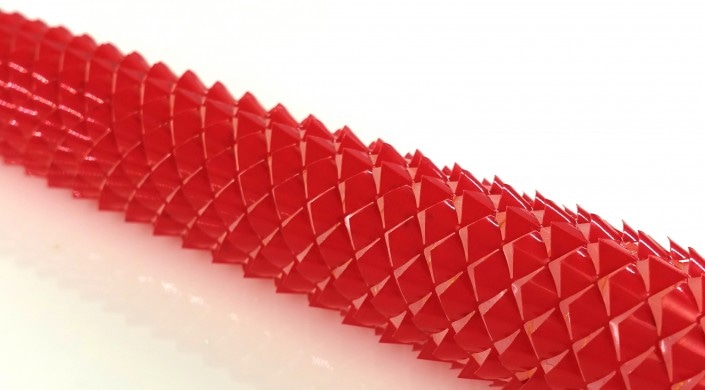Feb 25 2018
Snakes have no need for legs as their streamlined body enables them to slither nearly 14 miles per hour, slip into congested space, go up trees, and swim. They achieve all this by using their scales. During movement, the scales of a snake grip the ground and push the body forward; the same way crampons assist hikers to form footholds in slippery ice. Such friction-aided locomotion is viable due to the shape and positioning of the scales on the snake.
 This soft robot is made using kirigami—an ancient Japanese paper craft that relies on cuts, rather than origami folds, to change the properties of a material. As the robot stretches, the kirigami is transformed into a 3D-textured surface, which grips the ground just like snake skin. (Image credit: Ahmad Rafsanjani/Harvard SEAS.)
This soft robot is made using kirigami—an ancient Japanese paper craft that relies on cuts, rather than origami folds, to change the properties of a material. As the robot stretches, the kirigami is transformed into a 3D-textured surface, which grips the ground just like snake skin. (Image credit: Ahmad Rafsanjani/Harvard SEAS.)
At present, scientists from the Harvard John A. Paulson School of Engineering and Applied Sciences (SEAS) have created a soft robot that adopts those same principles of locomotion to slither without the need for rigid components. The soft robotic scales are formed based on kirigami, which is an ancient Japanese paper craft that is dependent on cuts, instead of origami folds, to alter the characteristics of a material. When the robot gets stretched, the flat kirigami surface is modified into a 3D-form surface gripping the ground similar to a snake’s skin.
The study has been reported in the Science Robotics journal.
There has been a lot of research in recent years into how to fabricate these kinds of morphable, stretchable structures. We have shown that kirigami principles can be integrated into soft robots to achieve locomotion in a way that is simpler, faster and cheaper than most previous techniques.
Ahmad Rafsanjani, First Author & Postdoctoral Fellow - SEAS
The scientists began the robot with a simple, flat plastic sheet. They used a laser cutter to form an array of centimeter-scale cuts, carrying out trials with distinctive sizes and shapes. After forming the cuts, the team wrapped the sheet around in the form of tube-like elastomer actuator that enlarges and shrinks with air similar to a balloon.
Upon expansion of the actuator, the kirigami cuts get popped out, thereby creating a rough surface for gripping the ground. Upon shrinking of the actuator, the cuts get folded flat, pushing the crawler forward.
The team developed a completely untethered robot and packed its integrated onboard control, actuation, sensing, and power supply into a small tail portion. To investigate it, they made it slither through the entire Harvard campus.
The researchers tested with cuts of distinctive shapes, such as circular, triangular, and trapezoidal, and discovered that the trapezoidal cuts enabled the robot to take longer strides as they look similar to the shape of scales on the snake.
“We show that the locomotive properties of these kirigami-skins can be harnessed by properly balancing the cut geometry and the actuation protocol,” stated Rafsanjani. “Moving forward, these components can be further optimized to improve the response of the system.”
We believe that our kirigami-based strategy opens avenues for the design of a new class of soft crawlers. These all-terrain soft robots could one day travel across difficult environments for exploration, inspection, monitoring and search and rescue missions or perform complex, laparoscopic medical procedures.
Katia Bertoldi, Senior Author & William and Ami Kuan Danoff Professor of Applied Mechanics
Bertoldi is also an Associate Faculty of the Wyss Institute for Biologically Inspired Engineering at Harvard University.
Yuerou Zhang, Bangyuan Liu, and Shmuel M. Rubinstein, Associate Professor of Applied Physics at SEAS, were the co-authors of the study. The National Science Foundation supported the study.
Snakeskin Robot